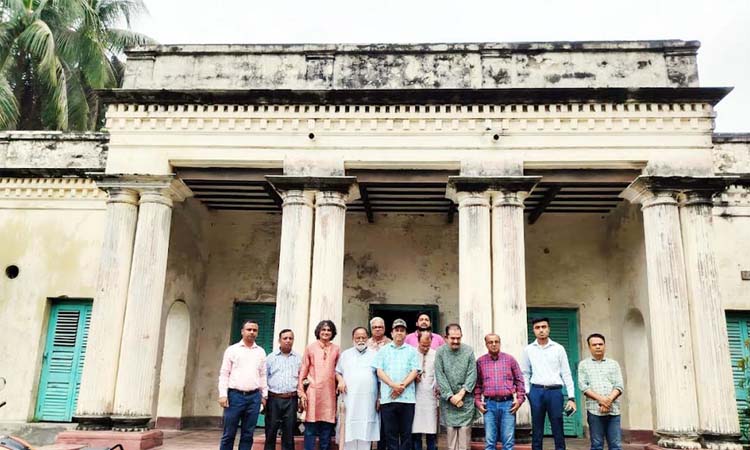News Flash

By Delwar Hossain
CUMILLA, Sept 15, 2025 (BSS) - The government has embarked upon a plan to preserve the birthplace of legendary singer and composer of Bengali and Hindi films Sachin Dev Burman best known as (SD Burman) in Cumilla and establish a full-fledged music museum there.
The Bangladesh National Museum authorities have already formed a three-member committee on the initiative of the Ministry of Cultural Affairs. This committee has started inspecting Sachin's residence and examining the feasibility.
Recently, a delegation led by Md. Serajul Islam, an official of the National Museum and convener of the Music Museum Committee, visited Sachin's residence located in Chartha, Cumilla city.
After visiting Sachin's residence, Md. Serajul Islam said, a three-member committee has been formed on the initiative of the Ministry of Cultural Affairs.
He said this committee will examine the feasibility of establishing the ancestral homes of renowned composer and musician SD Burman, born in Cumilla, and Ustad Alauddin Khan, a musical maestro and multi instrumentalist from Nabinagar, as museums in future.
"We have visited the two houses and I think there is sufficient validation for making museums here. We will inform the ministry about the matter. Hopefully, this initiative will be implemented soon and the two historical houses will reach new heights on the cultural arena of the country," he said,
Serajul Islam said that we are mulling over to build a full-fledged music museum and cultural complexes in the houses.
There will be documents of Sachin's life and work, music archives and research rooms, an open stage and cultural event venue, and a music education centre, he said.
Assistant Commissioner of the District Administration Hasibur Rahman Parag said, "Sachin Dev Burman's house is the pride of not only in Cumilla but also for the whole country. If there is a museum here, it will inspire future generations.”
Jahangir Alam Imrul, President of social organization Oitijhyo Cumilla, said that since 2012, cultural workers of Cumilla have been working continuously to preserve “Sachin Karta”'s residence.

In that continuity, the house has been rescued at various stages and a fair is organized every year on the occasion of Sachin Karta's birth anniversary, he said.
If a music museum is established here, domestic and foreign tourists will be able to learn about SD Burman and Cumilla will take a new place on the national and international arena, he said.
Music researchers say that this residence can be an invaluable centre for research on Sachin's life and works. University-level research and students will be able to directly use documents, photos, notations and audio-video archives. This will enrich the study of cultural history.
After all, SD Burman is not just a musician. He is a symbol of the cultural heritage of Cumilla and Bangladesh.
Therefore, preserving his birthplace is not a local but a national responsibility. If the government's recent initiative is implemented, this mansion in Cumilla will become an inspiration for the next generation of music lovers.
S D Burman was born on October 1, 1905 or 1906, (according to different sources) in Chartha, Cumilla. His father, Nabadwip Chandra Deb Burman, was the heir to the Tripura royal family.
Due to political unrest, the family moved to Cumilla and Sachin spent his childhood here. The Bhatiali, rural folk songs sung by the boatmen on the banks of the Gomti River and melodies of the Bede community sowed the seeds of music in his heart.
SD Burman first studied at Cumilla Zila School and later at Victoria College. He became known for singing while studying at Calcutta University. He drew everyone's attention by participating in the All India Music Conference in 1930.
His journey from Kolkata Betar to becoming a music director in the Mumbai film industry was a unique chapter.
Legendary artists like Lata Mangeshkar, Kishore Kumar, Geeta Dutt have sung to Sachin's tunes. At the same time, he has sung numerous songs with his own Bhatiali touch. His son R.D. Burman also added a new dimension to music in Indian cinema.
Sachin's birthplace was once a palace built on about 60 acres of land. During the Pakistan period, a part of it was used as a government farm. Even after independence, the mansion was subjected to encroachment, neglect and destruction. Many parts of the palace were demolished. The signs started to be erased. The demand for preservation has been strong since the 1990s at the insistence of the local cultural community.
In 2014, the district administration recovered a part of this palace. After that, partial renovation was done, but it was not fully implemented. 'Sachin Mela' started at the local level from 2018. In 2019, a mural of Sachin was erected inside the mansion at the initiative of the district administration. But although there were plans to build a full-fledged cultural complex, it was not implemented.